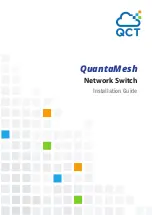
16-11
Catalyst 3560 Switch Software Configuration Guide
78-16156-01
Chapter 16 Configuring MSTP
Configuring MSTP Features
•
Propagation—When an RSTP switch receives a TC message from another switch through a
designated or root port, it propagates the change to all of its nonedge, designated ports and to the
root port (excluding the port on which it is received). The switch starts the TC-while timer for all
such ports and flushes the information learned on them.
•
Protocol migration—For backward compatibility with 802.1D switches, RSTP selectively sends
802.1D configuration BPDUs and TCN BPDUs on a per-port basis.
When a port is initialized, the migrate-delay timer is started (specifies the minimum time during
which RSTP BPDUs are sent), and RSTP BPDUs are sent. While this timer is active, the switch
processes all BPDUs received on that port and ignores the protocol type.
If the switch receives an 802.1D BPDU after the port’s migration-delay timer has expired, it assumes
that it is connected to an 802.1D switch and starts using only 802.1D BPDUs. However, if the RSTP
switch is using 802.1D BPDUs on a port and receives an RSTP BPDU after the timer has expired,
it restarts the timer and starts using RSTP BPDUs on that port.
Configuring MSTP Features
These sections describe how to configure basic MSTP features:
•
Default MSTP Configuration, page 16-12
•
MSTP Configuration Guidelines, page 16-12
•
Specifying the MST Region Configuration and Enabling MSTP, page 16-13
(required)
•
Configuring the Root Switch, page 16-14
(optional)
•
Configuring a Secondary Root Switch, page 16-16
(optional)
•
Configuring Port Priority, page 16-17
(optional)
•
Configuring Path Cost, page 16-18
(optional)
•
Configuring the Switch Priority, page 16-19
(optional)
•
Configuring the Hello Time, page 16-19
(optional)
•
Configuring the Forwarding-Delay Time, page 16-20
(optional)
•
Configuring the Maximum-Aging Time, page 16-21
(optional)
•
Configuring the Maximum-Hop Count, page 16-21
(optional)
•
Specifying the Link Type to Ensure Rapid Transitions, page 16-22
(optional)
•
Restarting the Protocol Migration Process, page 16-22
(optional)
















































